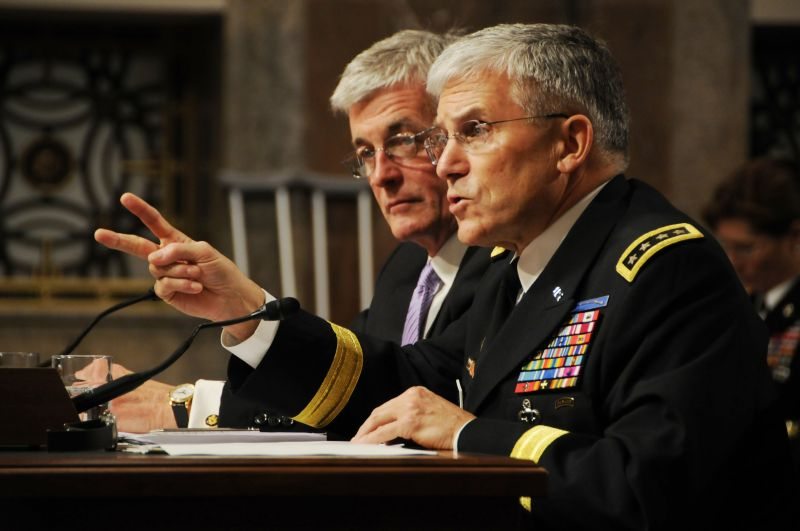The Army’s Fiscal Year 2012 budget request includes funding for a 1.5 percent pay raise for Soldiers, a 3.1 percent increase in housing allowance, and a 3.4 percent increase in subsistence.
The Army base budget request for FY 2012 amounts to $144.9 billion, an increase of just $1.5 billion over the FY 2011 request. The Army also requested an additional $71.1 billion for the overseas contingency operations, or OCO, budget — to fund operations in Afghanistan and to wrap up operations in Iraq.
The OCO budget request was $31 billion less than the FY2011 request, said Maj. Gen. Phillip McGhee, director, Army Budget, because Operation New Dawn in Iraq will end in December 2011.
Overall, the Army is asking in FY 2012 for about $29.5 billion less than it did in FY 2011. One place the Army is not asking for less money is the military personnel budget, or MILPERS.
“The Army leadership’s highest priority is caring for our people,” said McGhee. “That is our Soldiers, our families, and our civilian workforce — all with the goal of restoring balance across the Army, (and) continuing to build resiliency to sustain an all-volunteer force.”
The military personnel portion of the base budget comes to $60.6 billion, by far the largest portion of the Army’s budget. That portion of the budget provides the funding for Soldiers’ pay increase.
“Caring for our Soldiers and sustaining the quality of our all-volunteer force are the top priorities of the Army leadership,” McGhee said. “So in addition to caring for our Soldiers, the military personnel budget of $60.6 billion also achieves our manning objectives.”
In FY 2012, the Army continues maintaining the total force end strength of 1,110,600 it was authorized in FY 2011. That includes 547,400 for the active force; 358,200 for the Army National Guard; and 205,000 for the Army Reserve.
The OCO budget also includes $8 billion to support the active Army temporary troop increase of 22,000 Soldiers. That number will decrease to about 14,600 by the end of the year, and will zero out by the end of FY 2013.
The general also said the FY 2012 budget would focus on mainlining the Army’s “combat edge,” on training and equipping Soldiers and units for the current fight, and for reconstituting and modernizing the force.
The $45 billion operation and maintenance budget request is about a billion higher than last year’s request due primarily to more Soldiers in home station and available for training, McGhee said.
The Operation and Maintenance, or O&M, budget, he said, includes “a revised combined arms training strategy, that focuses and shifts training from major combat operations to full-spectrum operations, so funding will support 24 rotations to the Combined Arms Training Centers for all the Brigade Combat Teams and 33 war-fighting exercises for our multi-functional and our functional support brigades.”
The O&M budget also includes $900 million for recruiting and advertising and initial training for Soldiers; and provides for funding for 73 brigade combat teams, 98 multi-functional support brigades, and 133 functional and support brigades, McGhee said.
The Army’s procurement request for FY 2012 comes to $22.1 billion, about $800 million more than last year. The funding will support modernization of the UH-60M/HH-60M Black Hawk helicopter fleet, including $1.5 billion for some 71 new aircraft. An additional $1.4 billion is marked for modernization of the CH-47 Chinook helicopter from the “D” to the “F” model. The Army will purchase 32 new Chinooks in FY 2012.
Also part of the procurement budget: 88 Patriot Advanced Capability-3 missiles for $662 million, 710 Javelin missiles for $161 million, 2,784 Guided Multiple Launch Rocket System missiles for $314 million, and modifications to the Patriot missile system for $67 million. The Army expects to spend about $1.4 billion on missile procurement in FY 2012.
The Army also expects in FY 2012 to upgrade 21 Abrams tanks to M1-A2 vehicles, and to convert 100 Strykers into nuclear, biological, chemical reconnaissance vehicles.
As part of its $5.2 billion facilities budget, the Army will continue with investment in barracks in FY 2012 and will construct 128 new family housing units.
The four military services were directed by Defense Secretary Robert Gates to achieve $100 billion in efficiencies over the Fiscal Years 2012 to 2016 Future Years Defense Plan, or FYDP. The services would be allowed to retain and reinvest these efficiency savings in enhancements of their own high-priority war-fighting programs.
The Army found efficiencies through the consolidation of six Installation Management Command regions into four, for instance. Also, through portfolio reviews, the service determined it could terminate both the costly SLAMRAAM surface-to-air missile program and the Non-Line-of-Sight Launch System.
“Our DoD efficiency initiatives are enabling the Army to maintain our forces and our force structure in FY 2012,” said McGhee. “It will sustain an Army at war, it does build Soldier and family resiliency and it does help build our full-spectrum readiness and strategic flexibility.”
McGhee said of the $100 billion the DoD asked the services to find, the Army’s portion comes to $26 billion. In FY 2012, the Army found $2.6 billion in savings.










